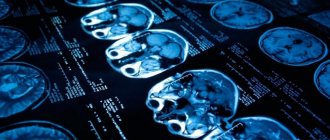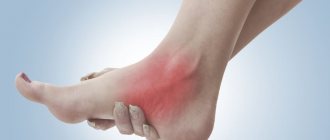| Advisory services | ||
| Initial consultation with a neurologist (60 min) | 1300 rub. | Sign up |
| Repeated consultation with a neurologist (30 min) | 700 rub. | Sign up |
Numbness and muscle weakness of the limbs are one of the symptoms of a pathological condition that affects blood vessels and nerve endings. According to medical statistics, a similar phenomenon occurs from time to time in 1/3 of the world's population. In some cases, it goes away on its own and does not pose a danger to humans, and in some cases the pathology must be treated.
What is hand numbness and its causes?
Many people are familiar with the unpleasant feeling of tingling, “crawling on the skin,” as well as pain, decreased sensitivity and deterioration of mobility in the limb. All of these manifestations characterize numbness, which can occur in the arms, legs and other areas of the body. It is associated with impaired blood circulation in the tissues or compression of the nerves.
Along with numbness in the hands, the following symptoms may also occur:
- burning sensation;
- muscle spasms;
- tingling sensation;
- pain in hands, fingers;
- feeling of itching;
- tingling and numbness that gets worse when you move your fingers;
- increased sensitivity to touch;
- pain in the cervical spine.
How to tell if you have dystonia
People who live with vegetative-vascular dystonia for quite a long time get used to their symptoms if they do not manifest themselves as crises and do not disrupt the normal course of life.
They learn to live with headaches, endure periodic numbness in their arms or legs, sometimes suffer from rapid heartbeat, and know that when the weather changes, they may experience insomnia. The rest of the time, VSD does not make itself felt and does not cause life-threatening conditions. But some manifestations of dystonia feel truly scary. A lump in the throat and a feeling of lack of air, palpitations and fear during panic attacks, sudden loss of consciousness, pressure changes. If after such an incident you were examined and no dangerous diseases were found, then with a high probability we can talk about VSD.
Numbness of the limbs with dystonia is usually associated with an unpleasant experience. Such a reaction of the body can occur even in anticipation of a pleasant event, from an excess of emotions.
Causes of numbness in the left hand:
- Cardiac ischemia. In addition to numbness in the left arm, there is discomfort in the chest. If after taking nitroglycerin or stopping the physical activity that caused the symptoms, these manifestations disappear, then it is angina pectoris. In addition to numbness of the left arm, it is accompanied by chest pain in the heart area, panic, pale skin, nausea, shortness of breath, and cold sweat.
- Myocardial infarction. Sometimes hand numbness is the only sign of this acute cardiovascular disaster. During an attack, the patient experiences intense pain and a feeling of constriction in the chest, shortness of breath, and interruptions in the functioning of the heart. The skin becomes covered with cold sweat. Along with numbness in the hand, a person experiences pain radiating to the lower jaw, stomach, and the area between the shoulder blades.
- Atherosclerosis. Due to atherosclerotic damage to the blood vessels, decreased strength and numbness in the arm may occur. Symptoms intensify when raising the limb upward.
- Stroke. Numbness in the left hand may indicate damage to the right hemisphere of the brain. In this case, the upper and lower limbs on the left side become numb, vision and speech are impaired. Along with numbness in the hand, a stroke can cause a complete loss of sensation in the hand. Other symptoms of cerebral hemorrhage include weakness in the limbs, loss of coordination, severe headache, blurred vision, nausea and vomiting, and irritation from bright lights and sounds.
- Vegetative-vascular, or neurocirculatory dystonia. This is a complex of autonomic disorders that is associated with disorders of nervous regulation. In addition to numbness of the left hand, it may be accompanied by headaches, insomnia, pressure fluctuations, arrhythmia, and panic attacks.
- Raynaud's disease. The pathology is accompanied by paroxysmal circulatory disorders in the arteries of the extremities. Along with the numbness of the hand, its rapid freezing is felt. In the cold and with excitement, a person’s fingers may turn blue. As Raynaud's disease progresses, not only the hands become numb, but also the legs, chin, nose, and ears.
- Vitamin B12 deficiency. This connection is extremely important for the normal functioning of nerve tissue. With its deficiency, a person not only experiences numbness in the hand, but also suffers from dry mouth and pale skin.
- Osteochondrosis (usually cervical and thoracic). First, the fingers go numb, then weakness develops in the upper limb, and the grip strength of the hand decreases. Sometimes pain is felt along the outside of the shoulder and forearm.
- Overstrain of muscles in the cervical-collar region. Pianists and PC operators suffer from hand numbness due to prolonged maintenance of the same position. The problem lies in the overstrain of the muscles, which compress the nerve fibers responsible for the sensitivity of the limbs.
- Insufficient blood circulation. The upper limb becomes numb due to impaired blood flow due to damage to the walls of blood vessels, for example, in diabetes mellitus.
- Stress and psycho-emotional overload can cause hand numbness.
- Carpal tunnel syndrome. When the median nerve passing through the wrist is compressed, the left hand may become numb. This problem is familiar to people of certain professions (programmers, musicians). Nerve compression can also occur in women during pregnancy due to swelling, as well as in patients after surgery, in obese people.
What will help restore sensitivity?
If during VSD your arms or legs are numb, you feel chills - take a hot shower, put on socks, wrap yourself in a warm blanket.
A hot drink will not only warm you up, but also activate reflex mechanisms that will return normal sensitivity to your limbs.
If numbness occurs after stress, take a sedative and try to sleep. For vegetative-vascular dystonia, Glycine is the best choice. Unlike herbal preparations, it will improve metabolism in nervous tissue at the cellular level and help recover from stress.
The combination of glutamic acid, glycine and cystine in Eltacin® helps to gradually bring dystonia under control and reduce the frequency of all symptoms. We recommend taking it in courses, as well as if your arms, legs or tongue become suddenly numb. After two or three courses of amino acids, manifestations of VSD will bother you less and less often, including sensory disturbances.
Numbness in the right hand may have the following causes:
- impaired blood flow, pinched nerve due to incorrect position of the limb (for example, during sleep);
- staying in an uncomfortable position for a long time (may be due to the nature of the work, for example, carpal tunnel syndrome);
- frequent carrying of bags, suitcases and other heavy objects;
- long exposure to frost or in a cold room;
- long-term muscle tension of the upper limb.
What is carpal tunnel syndrome
If a person’s work requires constant tension in the fingers and hands, then the median nerve of the hand can be pinched, which means the limbs go numb at night, the sensitivity of the wrist decreases, and pain is possible. Professions that require constant hand tension: tennis players, musicians, seamstresses, writers, guitarists, typists, dentists, etc.
The formation of tunnel syndrome is provoked by diabetes, excess weight, kidney failure, alcoholism, injuries, etc.
The phenomenon goes away on its own without any treatment if you allow yourself a long rest.
Why does hand numbness occur?
When a patient says that his upper limbs are numb, he may mean:
- a tingling feeling that causes discomfort;
- sensation of “goosebumps” under the skin;
- decreased sensitivity of the skin.
Numbness of the hands does not always indicate pathology. It may be the result of wearing too tight clothes and jewelry that compress blood vessels and nerves.
The most common causes of numbness in the hands:
- Uncomfortable body position, monotonous mechanical work, disrupting blood flow. After changing the position of the limb, the unpleasant sensations disappear.
- Carpal tunnel syndrome (usually affects the working hand due to prolonged monotonous work).
- Atherosclerosis. Accompanied by tingling and numbness of the hands, in the future a decrease in their muscle strength is likely.
- Osteochondrosis of the cervical spine (numbness, usually symmetrical, may intensify after physical activity).
- Diabetic neuropathy (usually both hands go numb).
- Intervertebral hernia in the cervical region (numbness is associated with compression of the spinal nerve roots).
- Ischemic stroke of the brain (threatens numbness and paralysis of the arm).
- Multiple sclerosis (if part of the postcentral gyrus of the brain is affected, the limbs may go numb).
- Thoracic outlet syndrome (compression of nerve trunks and blood vessels in the area of the upper chest opening).
- Brachial plexitis (numbness of the arm occurs due to inflammation of the brachial plexus).
- Damage to peripheral nerves due to alcoholism (alcoholic polyneuropathy).
- Brain tumor (the formation can compress the motor and sensory neurons responsible for the innervation of the upper extremities).
- Raynaud's disease (a disorder of the innervation of small arterioles, more common in women, manifested by numbness and pain in the extremities).
- Rheumatoid arthritis (inflammation and deformation of joints leads to compression of nerve fibers) and others.
Main services of Dr. Zavalishin’s clinic:
- consultation with a neurosurgeon
- treatment of spinal hernia
- brain surgery
- spine surgery
Diagnosis of the causes of hand numbness. How to identify?
At the appointment, the doctor examines and palpates the patient’s limb and asks the following questions:
- Where exactly is the numbness felt?
- When did the unpleasant tingling sensation and decreased sensitivity first appear?
- How long does numbness in a limb bother you?
- What actions and movements aggravate symptoms?
- Are there any other complaints, such as burning, itching, tingling, pain?
- How do your arms, hands, and fingers feel—cold or warm?
The main task of the doctor is to determine the causes of hand numbness. It is necessary to exclude systematic mechanical compression of blood vessels, as well as to determine household and industrial factors that could cause disturbances.
Numbness may be a harmless symptom, but it may also hide serious problems - myocardial ischemia, stroke, spinal problems, diabetes mellitus, amyotrophic lateral sclerosis, etc. In this case, the doctor issues a referral to doctors of relevant specializations (cardiologist, endocrinologist, neuropathologist, etc.).
The main emphasis in identifying the causes of numbness is on detecting signs of osteochondrosis. For this, the patient is referred for magnetic resonance imaging, radiography, computed tomography, and electromyography. The purpose of imaging studies for arm numbness is to determine the height of the intervertebral disc, detect osteophytes, and clarify the presence of protrusion or intervertebral herniation.
Approach the issue comprehensively
Numbness may be a symptom of a serious illness. In this case, you can get rid of it only if you cure this disease. The symptom will pass along with the disease.
Sometimes numbness is a consequence of an unhealthy lifestyle and an uncomfortable sleeping position. But don't expect it. that the problem will resolve itself, it is necessary to establish the cause and take care of restoring your own health.
Remember that self-medication and self-diagnosis will not bring anything good into your life. Contact specialists.
Principles of treating hand numbness
The primary task of the doctor is to identify the root cause of this symptom. For this purpose, radiography, myelography, MRI, blood tests, etc. can be performed.
Depending on the nature of the disease that caused numbness in the hands, treatment methods are selected. First of all, the underlying disease is treated. Drug treatment is supplemented by:
- physiotherapy;
- physical therapy;
- reflexology;
- massage;
- diet therapy;
- lifestyle correction.
Preventing numbness in the hands
In order to prevent discomfort in the upper extremities, it is recommended:
- exercise regularly (discuss the type and nature of exercise with your doctor in advance);
- maintain the health of blood vessels, joints and the body as a whole (give up bad habits, eat rationally);
- dress according to the season, keep your hands warm;
- take breaks every 40 minutes if your profession involves working on a PC or performing monotonous hand movements.
Treatment with folk remedies
The following recipes help with numb hands:
- as a compress or therapeutic bath, use a mixture of 2 liters of milk, 600 g of salt and 50 g of honey, heated to 60? C;
- apply an infusion of wild rosemary with apple cider vinegar (1:3) 3 times a day;
- infusion of garlic (several cloves) in vodka (400 ml) taken orally, 3-5 drops dissolved in water;
- for 1 liter of vegetable oil - 100 g of ground black pepper, cook for 30–40 minutes, rub the cooled product into the skin of the affected limb.
Treatment of hand numbness in specialized hospitals
Department of Neurosurgery, City Clinical Hospital named after. A.K. Yeramishantseva sees patients with complaints of numbness in their hands. Here, progressive methods of conservative and surgical treatment of diseases manifested by such symptoms are used. Advanced technical equipment and extensive professional experience of the medical staff guarantee good treatment results. Telephone.
Neurosurgeon Evgeniy Evgenievich Zavalishin treats diseases that cause numbness in the hands. Sign up for a consultation by calling 8 (499) 940-04-30.
Diagnostics
The nature of the pathology causing leg numbness is determined by neurologists. Patients with vascular damage require consultation with a phlebologist or vascular surgeon. The specialist determines the history of the disease, evaluates the appearance of the lower limb, determines pulsation in the arteries, identifies swelling, signs of inflammation, and trophic disorders.
A neurological examination involves determining reflexes, sensitivity, and muscle strength. The additional examination program may include the following procedures:
- Electrophysiological studies
. To clarify the level, severity and extent of nerve damage, electromyography and electroneurography are performed. - Radiography
. Indicated for injuries, suspected nerve compression by a tumor, inflammatory infiltrate, bone growths. - Sonography
. Doppler ultrasound and duplex scanning are used for arterial lesions and varicose veins. The techniques allow one to assess the speed and nature of blood flow, determine changes in the diameter of blood vessels, and the presence of collaterals. - MRI and CT
. Recommended for patients with suspected injuries or diseases of the central nervous system. They are prescribed at the final stage of the examination to clarify the nature, size and location of the pathological focus. - Laboratory research
. Produced to clarify the diagnosis of hypovitaminosis and parasitosis. Allows you to assess the severity of dysfunction of the body in case of poisoning.










